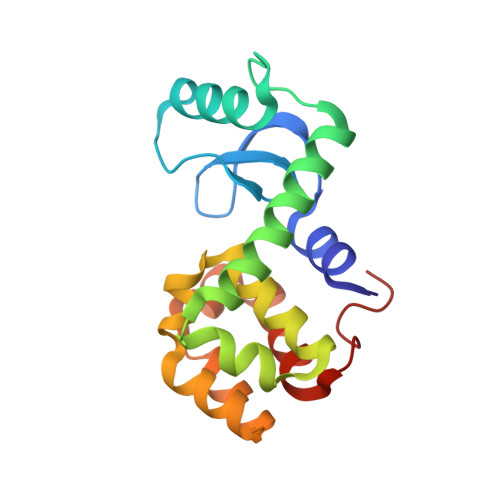Use of an ion-binding site to bypass the 1000-atom limit to structure determination by direct methods.
Mooers, B.H., Matthews, B.W.(2004) Acta Crystallogr D Biol Crystallogr 60: 1726-1737
- PubMed: 15388918
- DOI: https://doi.org/10.1107/S0907444904017020
- Primary Citation of Related Structures:
1SWY, 1SWZ, 1SX2, 1SX7 - PubMed Abstract:
Proteins with more than 1000 non-H atoms and without heavy-atom prosthetic groups are very difficult to solve by ab initio direct methods. T4 lysozyme is being used to explore these limits. The protein has 1309 non-H atoms, seven S atoms, no disulfide bonds and no heavy-atom prosthetic group. It is recalcitrant to structure determination by direct methods using X-ray diffraction data to 0.97 A. It is shown here that it is possible to obtain a truly ab initio structure determination of a variant of the protein that has an Rb+ (Z = 37) binding site. Using diffraction data to 1.06 A resolution, the direct-methods programs SIR2002 and ACORN independently solved the structure in about 20 h. The bound Rb+, which contributes about 1.7% of the total scattering, does not appear to distort the structure or to inhibit refinement (R factor 12.1%). The phases obtained via SIR2002 or ACORN are in good agreement with those from a reference structure obtained from conventional molecular-substitution and refinement procedures (average error in the figure-of-merit-weighted phases of less than 25 degrees). Thus, proteins with more than 1000 atoms that include halide-binding or other such sites may be amenable to structure determination by ab initio direct methods. The direct-methods approaches are also compared with structure determination via use of the anomalous scattering of the Rb+ ion. As shown by examples, high-resolution structures determined by direct methods can be useful in highlighting regions of strain in the protein, including short hydrogen bonds and non-planar peptide groups.
Organizational Affiliation:
Institute of Molecular Biology, Howard Hughes Medical Institute and Department of Physics, 1229 University of Oregon, Eugene, OR 97403-1229, USA.





















